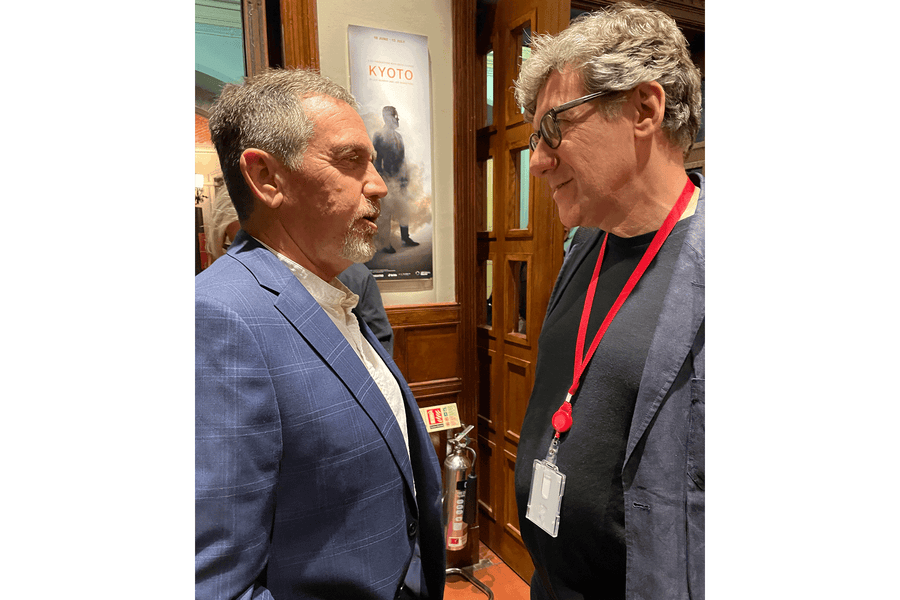It’s a very strange experience to watch a play in which you are a character—and to shake hands with the person who plays you. I did both this July while attending a performance of Kyoto at the Swan Theatre in Stratford-upon-Avon in England. The moment meant more, of course, than just a glimpse of oneself on history’s stage. The play shows how science won out over climate denial in a critical face-off between scientists and industry over the future of the planet.
Kyoto is a play about the Kyoto Protocol—an agreement made more than 25 years ago that as summarized by the United Nations, committed “industrialized countries and economies in transition to limit and reduce greenhouse gases (GHG) emissions in accordance with agreed individual targets.” Written by Joe Murphy and Joe Robertson, the play is a co-production of Good Chance and the Royal Shakespeare Company that provides a dramatic retelling of a historic meeting in Kyoto, Japan, in December 1997, where the protocol was finalized.
At this meeting, a key Intergovernmental Panel on Climate Change (IPCC) scientific assessment helped to inform the international emissions reduction negotiations—the Working Group I part of the IPCC Second Assessment Report, which was completed in 1995 and published in early 1996. I was convening lead author of chapter eight, “Detection of Climate Change and Attribution of Causes.” The role of the IPCC, back in 1995 and today, was to advise the governments of the world on the science and impacts of climate change, as well as on strategies for mitigating and adapting to those impacts.
On supporting science journalism
If you’re enjoying this article, consider supporting our award-winning journalism by subscribing. By purchasing a subscription you are helping to ensure the future of impactful stories about the discoveries and ideas shaping our world today.
In 1990 the first IPCC scientific assessment had concluded that the jury was still out on whether a human-caused climate change signal could be identified in real-world climate data. The 1995 assessment’s chapter reached a very different conclusion, encapsulated in 12 simple words: “The balance of evidence suggests a discernible human influence on global climate.” This was a powerful, historic statement from cautious scientists and a rather conservative organization.
Multiple factors contributed to this dramatic transition. Advances in the science of climate fingerprinting, for example, made a big difference in climate research during the five years between the two reports.
Fingerprinting seeks to understand the unique signatures of different human and natural influences on Earth’s climate. This uniqueness becomes apparent if we probe beyond a single number—such as the average temperature of Earth’s surface, including land and oceans—and look instead at complex patterns of climate change. Patterns have discriminatory power and allow scientists to separate the signature of human-caused fossil-fuel burning from the signatures of purely natural phenomena (such as El Niño and La Niña climate patterns, changes in the sun’s energy output, and effects of volcanic eruptions).
Kyoto describes some of the fingerprint evidence that was presented during a key meeting in Madrid in November 1995, ahead of the Kyoto face-off dramatized in the performance. The “discernible human influence on global climate” conclusion was finalized in Madrid, where the participants included 177 delegates from 96 countries, representatives from 14 nongovernmental organizations and 28 lead authors of the IPCC Second Assessment Report.

Ben Santer (left) in conversation with Dale Rapley (right), the actor playing Ben Santer in Kyoto.
As a lead author of the evidence chapter, I was there among them in that Madrid plenary room. So were several of the other characters in Kyoto, including the play’s central one—Donald Pearlman, who was a lawyer and lobbyist for the Climate Council, a consortium of energy interests.
Pearlman and I were on opposite sides of the Madrid chessboard. My efforts were directed toward synthesizing and assessing complex science and ensuring that the science was accurately represented in the IPCC report. His were directed toward delaying international efforts to reduce emissions of heat-trapping greenhouse gases. Such reductions were bad for the business interests he represented and for the revenues of oil-producing countries, such as Saudi Arabia and Kuwait.
Pearlman, who passed away in 2005, understood the singular importance of the Madrid “discernible human influence” conclusion. He knew it was the scientific equivalent of the Biblical handwriting on the wall. The jury was no longer out. Human-caused fingerprints had been identified in records of Earth’s surface and atmospheric temperature. Humans were no longer innocent bystanders in the climate system; they were active participants. Burning fossil fuels had changed the chemistry of Earth’s atmosphere, thereby warming the planet and sending Earth’s vital signs into concerning territory. The Madrid conclusion meant that the days of unfettered fossil-fuel use and carbon pollution were numbered.
It also made Pearlman’s lobbying job more difficult. His response was to attack the science and the scientists as part of a rearguard action to delay international agreement on reducing greenhouse gas emissions. As Pearlman’s character explains in Kyoto, it was a deliberate “scorched-Earth” strategy: torch the science and the scientists.
I had firsthand experience of this strategy in a memorable personal meeting with Pearlman in Washington D.C. on May 21, 1996. After I spoke at the Rayburn House Office Building in Congress about the scientific evidence for human fingerprints on global climate, Pearlman confronted me and started screaming at me—literally screaming. He expressed outrage at what he claimed were unauthorized changes to the chapter I had been responsible for. The changes had in fact been authorized by the IPCC, as Pearlman knew very well. He had been present at the Madrid meeting where the changes were discussed.
Ultimately he lost. Despite tremendous differences between countries in terms of their national self-interest, culpability for the problem of human-caused climate change and vulnerability to the effects of climate change, a historic international agreement was finally reached. The 1997 Kyoto Protocol commits participating countries to a common goal—that of reducing greenhouse gas emissions and avoiding “dangerous anthropogenic interference” in Earth’s climate system. The play Kyoto is the powerful story of how that agreement was achieved.
In one memorable line in Kyoto, Pearlman’s wife Shirley asks him: “Are we on the wrong side?” The question is prompted by an exposé of Pearlman’s lobbying activities in the German news magazine Der Spiegel. Shirley wants to know whether her husband’s efforts to cast doubt on the climate change science—and on the scientists involved in advancing that science—place them on the wrong side of history. The Pearlman character in the play responds by saying: “No, Shirley. We’re not on the wrong side.”
But Pearlman and the industries he represented were on the wrong side of the science. Nearly 30 years after the Madrid IPCC meeting, and after Pearlman’s concerted efforts to undercut climate science, human fingerprints on Earth’s climate are now unequivocal and ubiquitous. The cautious 1995 “discernible human influence” finding has been confirmed and strengthened by all four subsequent IPCC assessments. The scientists in Madrid got it right.
Pearlman and his employers were also on the wrong side of history. Today 191 countries have ratified the Kyoto Protocol. Although the U.S. Congress never did ratify it, the protocol helped to pave the way for the 2016 Paris Agreement. The serious consequences of human-caused global warming are now manifest to all, building momentum for real action to cut carbon pollution. The days of climate science denial are numbered.
But they are not quite over yet. Another Donald—former president Donald Trump—has repeatedly denied the reality and seriousness of climate change. It’s no surprise that his backers look a lot like Pearlman’s.
There is a very small probability that Trump will ever watch Kyoto. There’s an even smaller probability that Trump will consider whether he, too, is on the wrong side of science and history.
Sadly, he is. Trump’s possible return to the U.S. presidency would reprise Pearlman’s heyday, when manufactured doubt obscured mature scientific understanding. Kyoto tells the story of how that scientific understanding evolved and how powerful vested interests tried to destroy it. Giving that account today is absolutely vital, with the bill for climate change coming due all around us.
I hope Kyoto will have a discernible influence on millions around the world. I hope the play reaches audiences I could never dream of reaching through all the scientific papers I’ve ever written. And I hope it provides us with what mathematicians call an existence principle—proof that something difficult is possible. The existence principle in Kyoto is that humanity can and did come together in December 1997 and agreed to solve a seemingly intractable problem.
See Kyoto if you can. It will inspire you to find your own way of changing our world for the better.
This is an opinion and analysis article, and the views expressed by the author or authors are not necessarily those of Scientific American.








